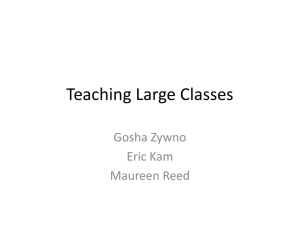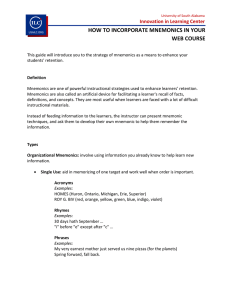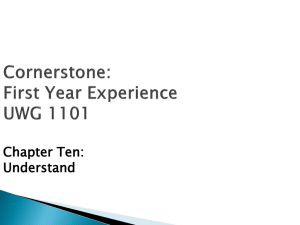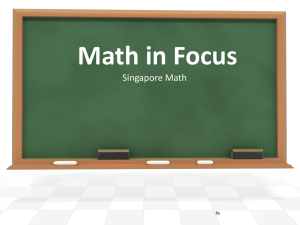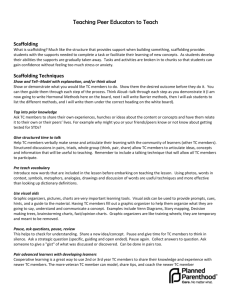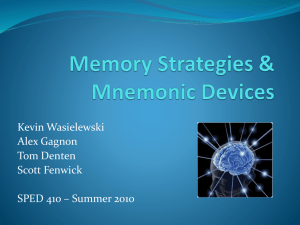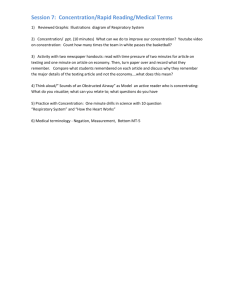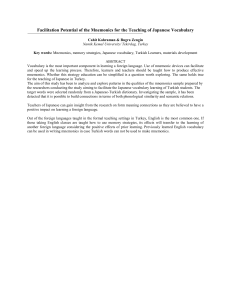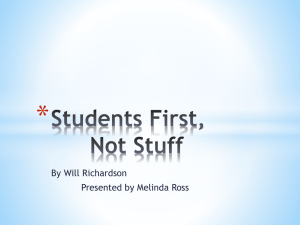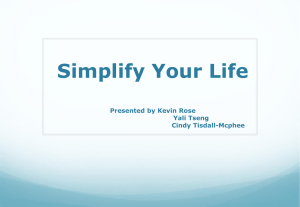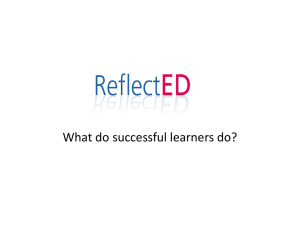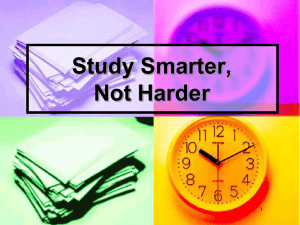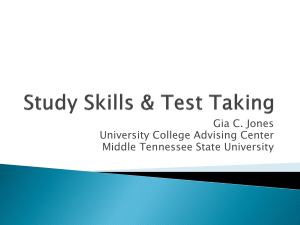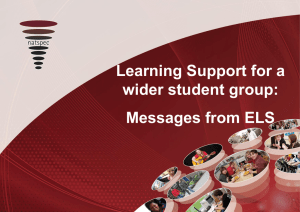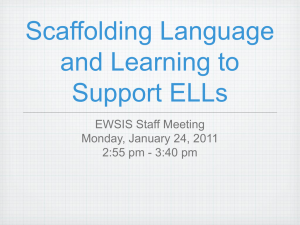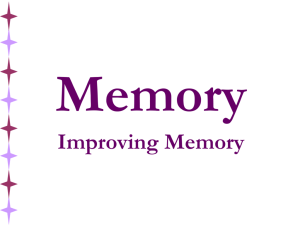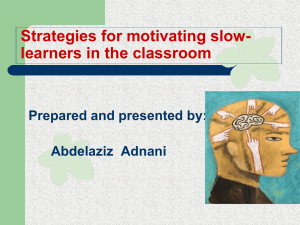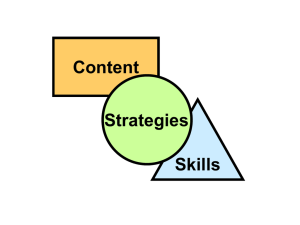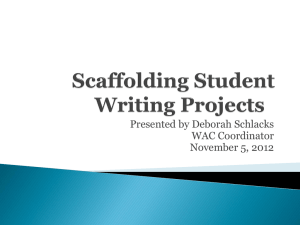Instruction to Meet the Needs of Diverse Learners
advertisement
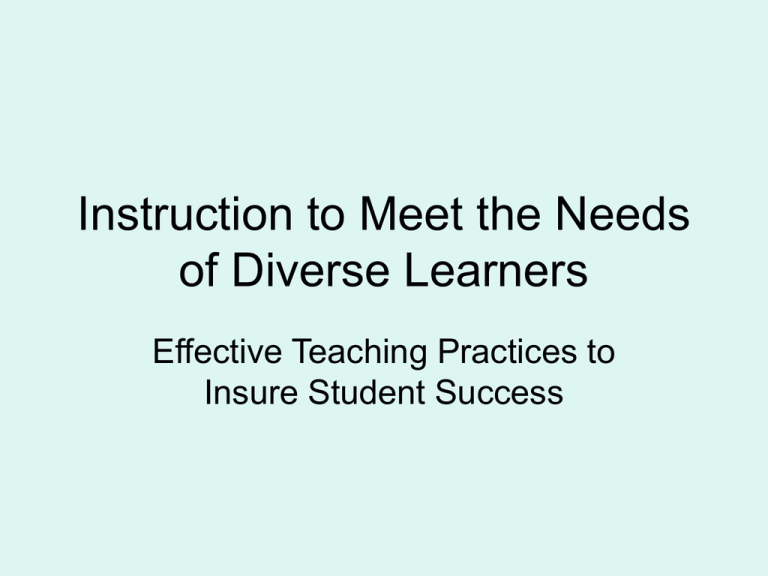
Instruction to Meet the Needs of Diverse Learners Effective Teaching Practices to Insure Student Success Inclusion Legally Required: LRE Access to General Curriculum Access to Peers Better Curriculum Higher Expectations Inclusion Issues • Assuming that exposure to class is enough • Placement without pre-planning • Not individualizing placement • Over or under using paraprofessionals • Focusing on activities-not objectives • Not utilizing explicit instruction Successful Inclusion All teachers responsible for ALL students Teach skills needed for success All teachers us effective teaching and behavior management-Universal Design Special Ed. provides ongoing support Frequent, regular monitoring of teachers and students (data gathering) Team problem solving Universal Design School established effective practice goals School wide rules Uniform classroom rules Procedures/expectations taught to all students High levels of OTR-Opportunities to Respond and student engagement Learning/study and organizational strategies explicitly taught to all students Teaching Practices Good teaching produces higher levels of appropriate behavior Good teaching produces higher levels of academic skills Good teaching produces greater learner progress Good teaching is a planned process-not a “seat of the pants” proposition Effective Learners Are engaged Are interactive Have a wide knowledge base Are active in their learning Are motivated from within Are goal driven Monitor their learning Can adjust behavior to not interfere with learning Ineffective Learners Are passive Do not interact appropriately Have a limited knowledge base Are not able to effectively monitor learning Externally motivated/controlled Are not goal oriented Behaviors interfere with learning Good Teaching New material is presented through teacher-led instruction Effective instructional methods used Practice activities are varied, motivating, and promote generalization of skills Students are engaged more that they are not Students participate in group activities Students are successful most of the time Learning is more rewarding than not learning Multi-Level teaching Homogeneous groups for reading and math instruction Whole group instruction for Social Skills, Social Studies, Science Paras assist with groups where available Use peer-tutoring, learning centers, projects, paired learning, etc. for students who are not with teachers Teacher should regularly teach every student Instructional Activities and Arrangements Large Group Small Group-most time here Individual Direct Teach (one on one) Direct Instruction-most time here Practice Ensuring Student Learning Provide high rates of active student responding (OTR) Provide immediate and complete error correction Teach Vocabulary!! Teach students learning tools (mnemonics, learning strategies Use research-based instruction Priming Conspicuous strategies Mediated scaffolding Judicious review Opportunities to Respond New Learning 4-6 opportunities per minute with 80% correct Review 8-12 opportunities per minute with 90% correct Active Student Responding Choral Responses Response Cards Guided Notes Choral Responding Provides high level of OTR Allows “anonymous” participation Teacher provides cue for when to respondvisual or auditory Uncertain responses-do firming Listen for errors-correct immediately Use individual responses for assessment and differentiation Response Cards Strong research support High motivational value Used in large groups, individually, in pairs Pre-printed or write on Teacher asks question, provides wait time, cues-students respond with cards Many variations-all effective Guided Notes “Tree” outline Flow Charts Venn Diagrams “Framing”-go to www.graphicorganizers.com for ideas Guided notes provide a structure-beneficial if all students in a school are taught a basic “frame” in common. Error Correction Be explicit Be immediate Lead to independence (refer to rule or strategy during correction) Explicit Instruction Tell students what you want them to learn Give very clear, direct instructions Demonstrate/model/guided practice/independent practice Model/lead/test format Clear, consistent error correction Correct response-acknowledge Incorrect response-correct Uncertain response-firm www.cast.org/publications/ncac/ncac_explicit.html www.xnet.rrc.mb.ca/glenh/understanding_by_design.htm For good ideas for lesson design and evaluation Priming Background Knowledge Relating knowledge that students must know to learn a new skill, concept, or strategy Plan before lesson-”What do students need to know before they can learn this?” Question-discuss-review this background knowledge BEFORE presenting new skill Examples of Priming K-W-L: What do I know, what do I want to know, what have I learned? Direct instruction curricula (scripted lessons) Beginning of class warm-ups Graphic organizers Conspicuous Strategies Teach learners the “tricks of the trade”-what the experts know Examples: Reminder acrostics “Rules”: Silent “e” makes the vowel say its name. How do “experts” find the main idea of a passage/ How do “experts” set up a math problem from a story problem? Mediated Scaffolding High levels of support in the early stages of learning Gradually fade support as student masters skills For ideas: go to www.projects.edtech.sandi.net/staff development/presentation/scaffolding.htm Judicious Review Well thought out Well planned Carefully reflects what they need to know Continuous-spirals with additional knowledge throughout the year Vocabulary Vocabulary knowledge has been proven to be critical to school success Vocabulary development is a fundamental goal for early grades The vocabulary gap widens in early grades Explicitly teaching vocabulary is essential at all grades Teaching Vocabulary Provides students skills and opportunities to learn vocabulary independently Teaches students the meanings of unfamiliar words and concepts Fosters an appreciation and awareness of words and their use Brings words to life-encourages word play Direct Vocabulary Instruction Provides clear, understandable, kidfriendly definitions Uses both definitions and context Provides lost of varied opportunities to interact with words Provides lost of review and opportunities for learning (English language learner dictionaries are a good source of kid friendly definitions) Vocabulary Strategy-LINCS 1) List the word and definition 2) Indicate a reminding word (looks likesounds like) 3) Note a LINCing story 4) Construct a LINCing picture 5) Self-Test LINCS Example • Compromise Essential definition: an agreement, where each gives up something Reminding word: promise LINC-ing story: Both promised to give up something to reach an agreement. LINC-ing picture: Levels of Vocabulary No knowledge General sense Narrow context-bound knowledge Knowledge of a word without ability to recall and use it in appropriate situations Rich, decontextualized knowledge of a word’s meaning, its relationship to other works, and its extension to metaphorical uses (Beck, McKeon & Kucan, 2002) Mnemonics Keywords Letter Strategies (acrostics,acronyms) Pegwords Research supports the use of mnemonics as a learning strategy for diverse learners. These techniques make learning easier. Keywords For vocabulary or pairs of information Involves elaboration and imagery Students use background knowledge to learn new concepts and vocabulary Ex: Arkansas-picture of an ark being sawed in half Ex: Handel-Baroque composer Picture of a man bringing broken(baroque) handle bars (Handel) to a bikeshop Letter Strategies ROYGBIV-order of colors in rainbow Please excuse my dear aunt Sally-order of operations in math FACE-space notes Every good boy does fine: line notes Use letter strategies for lists of information. Pegwords For numbered or ordered information Involves elaboration and imagery combined with pegwords (words associated with numbers) In general, teach all kids one set of pegwords- Scruggs and Mastropieri have one, Quantum list is another-kids can “tweak” as they wish Pegword Example one is a bun two is a shoe three is a tree four is a door five is a hive six is sticks seven is heaven eight is a gate nine is a line ten is a hen Other methods much like pegwords are also useful: go to www.memory-key.com/mnemonics/list-learning.htm Learning Strategies There are many learning strategies that have been field tested with students with disabilities: Decoding-DISSECT Writing-TOWER Math-DRAW Listening-SLANT Test-Taking-SCORER Organization-PREP/WISE http://www.ku-crl.org (materials for purchase) www.ldonline.org www.teachingld.org
